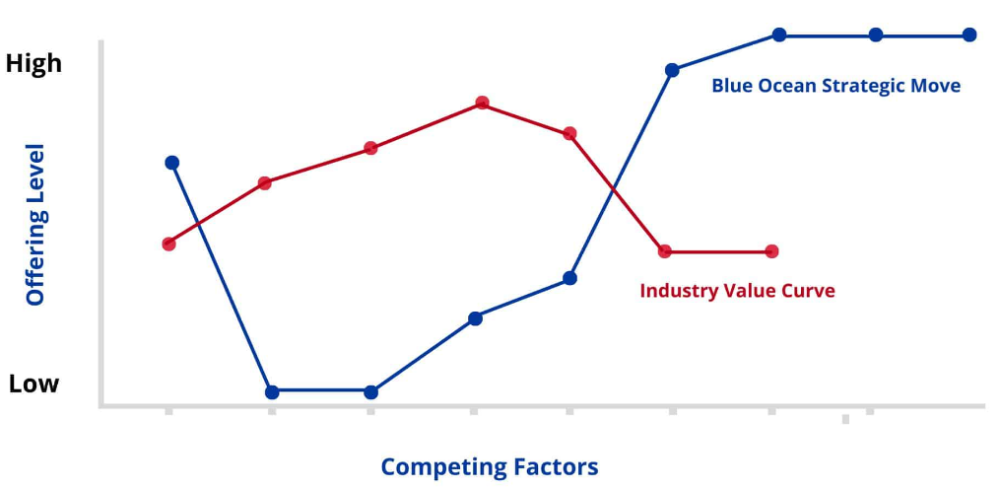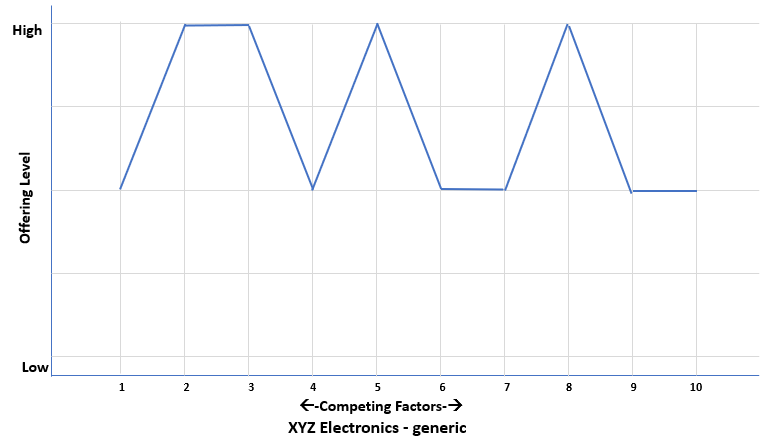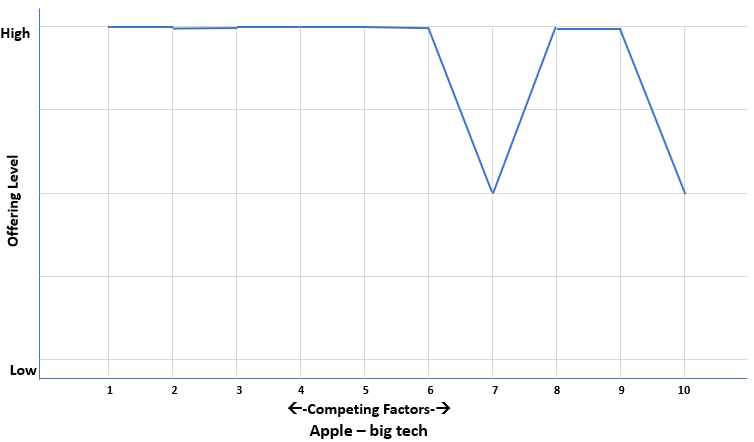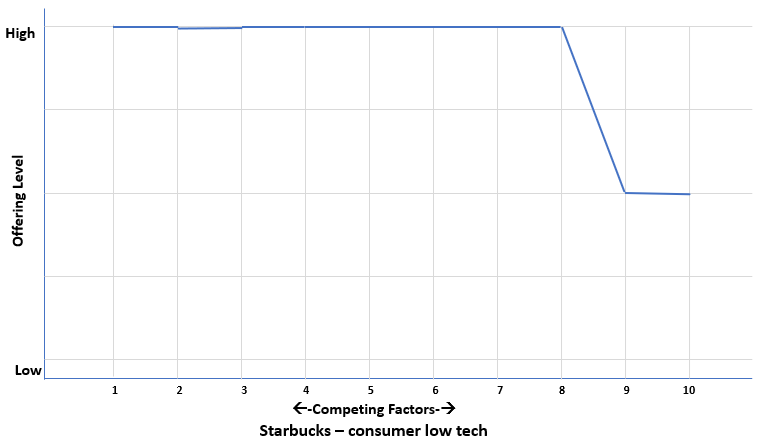This post explains what the Strategy Canvas tool is, and how to create a basic Strategy Canvas. It then walks through several examples – generically and for two real companies. Finally, it details the use and benefits of the tool for practicing strategy and project management.
What is the Strategy Canvas Tool?

The Strategy Canvas tool is a management tool introduced by W. Chan Kim and Renée Mauborgne in their book “Blue Ocean Strategy.” It is used to visually represent a company’s competitive landscape and strategic positioning relative to its competitors.
The canvas consists of two axes: the horizontal axis represents different factors or attributes that are important to customers in the industry, and the vertical axis represents the level of offering or value that the company provides for each of these factors.
By plotting these factors and the corresponding value offered by the company and its competitors on the canvas, businesses can gain insights into their competitive positioning and identify areas where they can innovate and differentiate themselves. It helps in strategic planning by highlighting opportunities for creating a “blue ocean” of uncontested market space, where competition is irrelevant or minimal.
How to Create a Blue Ocean Strategy Canvas
First, let’s talk the basics.
Imagine a graph with two axes:
- Horizontal Axis – This axis represents the key factors or attributes that are important to customers in your industry. These could include price, quality, convenience, customer service, features, etc. Each factor is labeled along this axis.
- Vertical Axis – This axis represents the level of offering or value provided by your company and your competitors for each of the key factors. The level of offering can be measured on a scale from low to high.
For example, if one of the factors is “Price,” and your company offers relatively low prices compared to competitors, you would plot your company’s value higher on the vertical axis for this factor.
Similarly, if another factor is “Quality,” and your company provides high-quality products compared to competitors, you would plot your company’s value higher on the vertical axis for this factor.
Now do the same thing for other factors. Once all the factors are plotted, you can see a visual representation of your company’s competitive positioning relative to competitors. This allows you to identify areas where your company is performing well and areas where there is room for improvement.
Now, let’s step it up a level in detail.
Here are the basic steps to create a Strategy Canvas:
- Identify Key Factors – Determine the key factors or attributes that are important to customers in your industry. These could include price, quality, convenience, customer service, features, etc.
- Plot the Current State – Create a graph with the identified factors on the horizontal axis and the level of offering or value provided by your company and your competitors on the vertical axis. Plot the current state of your company and your competitors – or at least a proxy for the industry – on the canvas by drawing lines or points for each factor.
- Analyze the Canvas – Examine the canvas to understand your competitive positioning. Identify areas where your company is performing well compared to competitors and areas where there is room for improvement.
- Strategic Planning – Use the insights gained from the canvas to inform your strategic planning. Look for opportunities to innovate and differentiate your offering to create a “blue ocean” of uncontested market space.
- Iterate and Refine – As your business evolves and the competitive landscape changes, continue to update and refine your strategy canvas to ensure that your business remains competitive.
You can use various tools like Microsoft Excel, PowerPoint, Visio, Lucid, Google Sheets, or specialized software for creating strategy canvases. Simply create a graph with the necessary axes and plot your data points accordingly.
Let’s Build a Generic Strategy Canvas

Let’s consider a fictional company, XYZ Electronics, which manufactures and sells smartphones. Here’s an example of the factors considered and their value on the strategy canvas:
- Price – XYZ Electronics offers smartphones at a competitive price point, slightly lower than most competitors. Value: Moderate.
- Quality – XYZ Electronics’ smartphones are known for their high build quality and reliable performance, comparable to leading brands. Value: High.
- Features – XYZ Electronics includes innovative features in their smartphones, such as advanced camera technology and long-lasting battery life. Value: High.
- Design – The design of XYZ Electronics’ smartphones is modern and sleek, appealing to customers who prioritize aesthetics. Value: Moderate.
- Customer Service – XYZ Electronics provides excellent customer service, with responsive support and hassle-free warranty claims. Value: High.
- Brand Reputation – While XYZ Electronics is relatively new in the market, it has been gaining positive reviews and is building a strong brand reputation. Value: Moderate.
- Distribution Channels – XYZ Electronics sells its smartphones through both online and offline channels, ensuring accessibility to a wide range of customers. Value: Moderate.
- After-Sales Support – XYZ Electronics offers regular software updates and security patches, enhancing the longevity of their smartphones. Value: High.
- Customization Options – XYZ Electronics allows customers to customize certain features of their smartphones, such as colors and storage capacity, providing a personalized experience. Value: Moderate.
- Environmental Impact – XYZ Electronics prioritizes sustainability and uses eco-friendly materials in its smartphone production, appealing to environmentally conscious consumers. Value: Moderate.
This description outlines the various factors considered in XYZ Electronics’ strategy canvas and their perceived value relative to competitors. Part of the exercise – not shown – is to include a plot for industry competitors (aggregate) or multiple individual competitors.
By analyzing these factors, XYZ Electronics can identify areas where it excels and areas where it can focus on improving its competitive positioning to gain a competitive advantage.
Now Let’s Try It for a Big Tech Company – Apple

Let’s consider a real company: Apple Inc., known for its innovative products like the iPhone, iPad, and Mac computers. Here’s an example of a strategy canvas for Apple:
- Price – Apple products are typically positioned as premium offerings, priced higher than many competitors’ products. Value: High.
- Quality – Apple is renowned for its high build quality, sleek design, and attention to detail, leading to excellent overall product quality. Value: High.
- Innovation – Apple continuously introduces groundbreaking features and technologies in its products, setting industry standards for innovation. Value: High.
- Design – Apple’s products are known for their iconic and minimalist design, which appeals to consumers looking for stylish and modern technology. Value: High.
- Customer Experience – Apple prioritizes customer experience, offering seamless integration between its hardware, software, and services ecosystem. Value: High.
- Brand Reputation – Apple has a strong brand reputation, associated with innovation, quality, and status, leading to customer loyalty and trust. Value: High.
- Retail Presence – Apple operates a network of sleek and modern retail stores worldwide, providing customers with a unique shopping experience. Value: Moderate.
- Ecosystem Lock-in – Apple’s ecosystem of products and services creates a lock-in effect, where customers are incentivized to stay within the Apple ecosystem for compatibility and convenience. Value: High.
- Customer Service – Apple offers excellent customer service through its AppleCare support programs, ensuring timely assistance and resolution for customer issues. Value: High.
- Sustainability Efforts – Apple emphasizes sustainability and environmental responsibility, incorporating recycled materials and renewable energy into its product manufacturing processes. Value: Moderate.
This strategy canvas provides a simplistic overview of Apple’s competitive positioning across various factors relative to its competitors. It highlights Apple’s emphasis on premium quality, innovation, design, and customer experience as key drivers of its success in the technology industry.
Let’s Try It for a Low Tech Company – Starbucks

Let’s move away from tech and consider Starbucks Corporation, the global coffeehouse chain known for its premium coffee, tea, and café-style beverages. Here’s an example of a strategy canvas for Starbucks:
- Price – Starbucks’ products are positioned at a premium price point compared to traditional coffee shops, reflecting the quality and experience offered. Value: Moderate to High.
- Quality – Starbucks is renowned for its high-quality coffee beans, carefully sourced and roasted to deliver rich flavor and consistency. Value: High.
- Variety – Starbucks offers a wide variety of coffee beverages, teas, and specialty drinks, catering to diverse customer preferences and tastes. Value: High.
- Customer Experience – Starbucks prioritizes the customer experience, providing a welcoming ambiance, friendly service, and comfortable seating in its stores. Value: High.
- Convenience – Starbucks’ extensive network of stores and drive-thru locations makes it convenient for customers to access their favorite beverages on the go. Value: High.
- Brand Reputation – Starbucks has a strong brand reputation associated with quality, consistency, and social responsibility, leading to customer loyalty and trust. Value: High.
- Innovation – Starbucks continually introduces new beverage offerings and seasonal promotions to keep its menu fresh and exciting for customers. Value: Moderate to High.
- Digital Engagement – Starbucks’ mobile app and loyalty program enhance the customer experience by allowing for mobile ordering, payment, and personalized rewards. Value: High.
- Community Engagement – Starbucks engages with local communities through initiatives like ethical sourcing, environmental sustainability, and charitable donations. Value: Moderate.
- Food Options – Starbucks offers a variety of food options, including pastries, sandwiches, and snacks, complementing its beverage offerings and attracting a wider customer base. Value: Moderate.
This simplistic strategy canvas example illustrates Starbucks’ competitive positioning in the coffeehouse industry, emphasizing its focus on quality, variety, customer experience, and innovation as key drivers of its success.
The Use of the Strategy Canvas in Practicing Strategy
The Strategy Canvas is a valuable tool in strategic planning and can be used in various contexts. Here are some situations when it’s beneficial to use the Strategy Canvas:
- Strategic Analysis – Use the Strategy Canvas to analyze your company’s competitive positioning relative to competitors. It helps identify areas where your company excels and areas where there is room for improvement.
- Strategic Planning – Use the insights gained from the Strategy Canvas to inform your strategic planning process. It helps identify opportunities for differentiation and innovation to create a compelling value proposition for customers.
- New Market Entry – When entering a new market or launching a new product, the Strategy Canvas can help assess the competitive landscape and identify unmet customer needs or underserved segments.
- Performance Evaluation – Use the Strategy Canvas to monitor and evaluate the effectiveness of your strategic initiatives over time. It helps track changes in competitive positioning and customer preferences.
However, there are also situations when the Strategy Canvas may not be the most appropriate tool to use:
- Complex Industries – In highly complex industries with numerous factors and variables influencing competitive positioning, the Strategy Canvas may oversimplify the analysis and provide limited insights.
- Dynamic Markets – In rapidly changing markets where customer preferences and competitive dynamics evolve quickly, the Strategy Canvas may not capture the dynamic nature of the industry effectively.
- Commodity Markets – In commodity markets where products or services are highly standardized and differentiation is minimal, the Strategy Canvas may not provide significant insights into competitive positioning.
- Niche Markets – In niche markets with specialized customer segments and unique value propositions, the Strategy Canvas may not accurately represent the competitive landscape or customer preferences.
In summary, the Strategy Canvas is a valuable tool for strategic analysis and planning, especially in industries with clear competitive factors and well-defined customer segments. However, its effectiveness may be limited in complex, dynamic, or niche markets where other tools or approaches may be more appropriate.
The Strategy Canvas for the Strategic PM?
With lots of enthusiasm for the potential of the Strategy Canvas, I asked myself, “Where might the Strategy Canvas help in the practice of project, program, and portfolio management?”
While the Strategy Canvas is primarily used in strategic planning and business strategy, it can also be applied in the practice of project, program, and portfolio management in certain contexts. Situations involving agile approaches, disruption, employing SAFe agile methods are ripe to leverage the Strategy Canvas.
Here are some cases where the Strategy Canvas might be useful in these domains:
- Project Selection – When selecting projects to include in a portfolio, the Strategy Canvas can help evaluate each project’s alignment with the organization’s strategic objectives. By comparing the value proposition of each project against key strategic factors, project managers can prioritize projects that contribute most effectively to the organization’s overall strategy.
- Project Prioritization – Within a project portfolio, the Strategy Canvas can assist in prioritizing projects based on their potential impact on strategic goals and the organization’s competitive positioning. Projects that offer unique value or address critical strategic factors may be given higher priority in resource allocation and execution.
- Program Alignment – In program management, the Strategy Canvas can be used to ensure alignment between program objectives and strategic priorities. By mapping program components or initiatives against key strategic factors, program managers can identify synergies, gaps, or conflicts and adjust program plans accordingly to maximize strategic impact.
- Performance Measurement – The Strategy Canvas can serve as a tool for monitoring and measuring the performance of projects, programs, and portfolios over time. By tracking changes in competitive positioning, customer value, and strategic alignment, project managers can assess the effectiveness of their initiatives and make adjustments as needed to stay on course with strategic objectives.
- Risk Management – Identifying and managing risks is a critical aspect of project, program, and portfolio management. The Strategy Canvas can help project managers anticipate and mitigate risks related to changes in competitive dynamics, shifts in customer preferences, or disruptions in the strategic landscape that may impact project success.
- Stakeholder Communication – Visual representations such as the Strategy Canvas can be effective communication tools for engaging stakeholders in project, program, and portfolio management. By illustrating how project initiatives contribute to broader strategic goals and competitive positioning, project managers can garner support and alignment from key stakeholders.
In summary, while the Strategy Canvas is traditionally associated with strategic planning and business strategy, its principles can be adapted and applied in project, program, and portfolio management to enhance alignment with organizational objectives, improve decision-making, and drive strategic impact.
Conclusion
This post explained what the Strategy Canvas tool is, and how to create a basic Strategy Canvas. It then walked through several examples – generically and for two real companies. Finally, it detailed the use and benefits of the tool for practicing strategy and project management.
Have you used the Strategy Canvas tool, and if so, what did you learn?
The following are two related posts in the blog about Blue Ocean strategy:
- Blue Ocean Leadership: Strong Blue Ocean Strategy Execution
- Executing Blue Ocean Strategy with Solid Project Management
The following is a nicely explained 3-minute video by Dr. Raj Ramesh providing further examples – this time in the airline industry – of the Strategy Canvas.